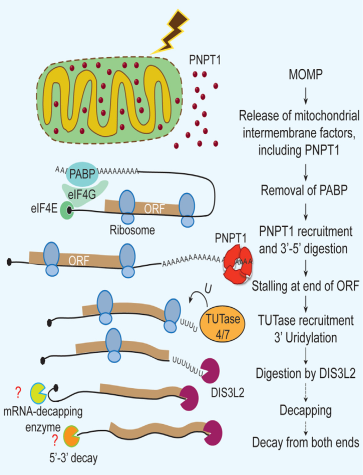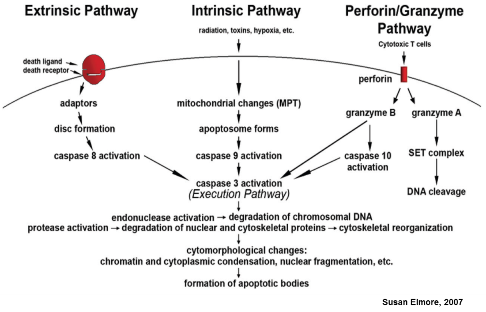Poly(A) RNAs Decay Triggered by PNPT1 Released from Mitochondria in Apoptosis
Apoptosis studies has mostly focused on protein degradation by the caspases, MOMP and DNA fragmentation but little is known about the fate of RNA. Judy Lieberman discovered new mechanism of RNA decay.
PNPT1 Initiates Apoptotic RNA Decay and Promotes Apoptosis
Source
Department of Pediatrics, Harvard Medical School, Boston, MA
Highlights
- Global decay of polyadenylated RNAs depends on MOMP and begins at the 3’ end
- 3’ to 5’ exoribonuclease PNPT1 is released from mitochondria during MOMP
- PNPT1 initiates apoptotic RNA decay and promotes apoptosis
- 3’ structures or protein binding of noncoding RNA prevent their degradation by PNPT1

Triggers Decay of Poly(A) RNAs
Apoptosis and Mitochondria
Apoptosis plays an important role in tissue remodeling during development, removal of damaged cells, pathogen immune defense, cancer surveillance, and the effectiveness of cancer therapy. Classical apoptosis is initaited by BCL-2 family-mediated mitochondrial outer membrane permeabilization (MOMP) and activates caspase proteases. Apoptosis can be triggered by cell death receptor ligands (FasL and TRAIL) which activate caspases-8 and -10 (extrinsic pathway), or by internal stresses (intrinsic pathway), which in turn activates caspase-2, or by cytotoxic lymphocyte granzymes (Gzm) that cleave Bid to truncated t-Bid to activate MOMP. Mitochondria play a vital role in apoptosis.
Apoptosis studies has mostly focused on protein degradation by the caspases, MOMP and DNA fragmentation but little is known about the fate of RNA. Nuclear export of newly synthesized RNAs and mRNA splicing are disrupted during apoptosis. mRNA decay occurs early after apoptosis triggered by diverse classical apoptotic stimuli such as cytotoxic attack, death receptor ligation, staurosporine [STS], etoposide, tunicamycin, and thapsigargin.
Previous studies shows that during apoptosis, mRNA decay intermediates with nontemplated 3’-oligouridylate additions near the stop codon are generated by 3’ terminal uridylyl transferases (TUTase), TUT4 and TUT7. The uridylated intermediates are further degraded by the 3’-5’ exoribonuclease DIS3L2, which preferentially recognizes oligouridylated 3’ ends.
Discovery of Mechanism of RNA Decay
Judy Lieberman discovered new mechanism of RNA decay. They first checked whether MOMP is required for mRNA decay in apoptosis or not, for that they used model where TRAIL treated HCT116 cells in which Bax is released and it is essential for cell death. mRNA decay of housekeeping genes detected after TRAIL treatemnt, indicating that MOMP leads to mRNA decay. mRNA decay occurs early in apoptosis, but after MOMP. As well as BCL2 overexpression completely blocked housekeeping gene mRNA decay and inhibited apoptosis.
Their study also suggest Poly(A) RNAs/mRNA decay preferentially compare to ncRNAs. Different experiments by the group also suggests mRNA decay begins at the 3’ end. They hypothesized that MOMP initiates RNA decay by releasing a mitochondrial IMS factor. They found that Mitochondrial IMS factor decay 3'-poly(A) ACTB mRNA. Mitochondria release an active RNase during MOMP.
From 127 candidate IMS proteins of mitochondria, only one is known to act on RNA. PNPT1, the mitochondrial polynucleotide nucleotidyl transferase, which is a 3'-5' exoribonuclease. MOMP-causes release of PNPT1 which starts RNA decay. PNPT1 is released from mitochondria during apoptosis and binds to poly(A) RNAs. This study also suggest that cytosolic PNPT1 causes mRNA decay and apoptosis on its own (overexpression of PNPT1). Structural analysis shows PNPT1 make tight central channel structure which bind to 3' unstructured RNA. Secondary structures inhibits RNA decay.
RNA decay is a key event only in MOMP-dependent apoptosis.
Journal Reference
Liu, X., Fu, R., Pan, Y., Meza-Sosa, K.F., Zhang, Z., Lieberman, J., 2018. PNPT1 Release from Mitochondria during Apoptosis Triggers Decay of Poly(A) RNAs. Cell 174, 187-201.e112. https://doi.org/10.1016/j.cell.2018.04.017

